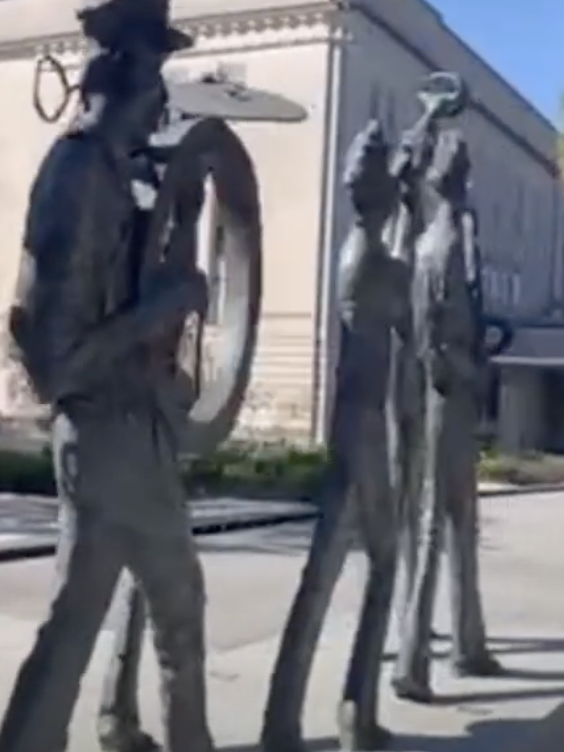Editor’s Note: We know how hard it is right now; we’re living through it with you. Some of us are asking, how can we keep doing this? That’s why this week were focusing on how being part of the New Orleans community means being part of something unlike anywhere else in the world. Yes, we’ll be highlighting small businesses and art adventures that make this city beyond special, and we’re also highlighting all of you that offer water, freezer cleaning, or a place to plug in the phone and cool off during the Ida-aftermath. Stay strong, All!
What: The Treme Neighborhood in New Orleans
Film by: UNO student and filmmaker Maya Fernbaugh
Editor’s Note: Maya Fernbaugh, the director of this video, encapsulates the rich history and stories of the Treme neighborhood in New Orleans. The Treme neighborhood is the oldest African American neighborhood in the United States. There are multiple video clips and images of well-known historical areas of this neighborhood, as well as the stories behind what made them so incredibly important to New Orleans history and culture. The video is full of images and information regarding what occurred in this neighborhood throughout history and how it has affected New Orleans to this day.
Full Transcription:
For over 200 years, the Treme neighborhood in New Orleans has existed as the oldest African American neighborhood in the United States.
With such rich history and a melting pot of culture, this neighborhood holds a historical significance to New Orleans.

The immigration of Haitian refugees during the Haitian revolution of the early 1800s is what gave birth to this neighborhood.
The neighborhood is named after Claude Treme, a French milliner and property owner.
This neighborhood became an entertainment center for white and black Creoles to congregate.
The addition of Haitian immigrants adds more abundance of culture to the New Orleans area, adding Haitian influence to a New Orleans melting pot of Spanish, French, and African American culture.
New Orleans at the time was still bound to the French Quarter.
The Treme and other outside neighborhoods were originally farms or swamps.
Many claim that the Treme is the birthplace of jazz as well, home to great musicians such as Trombone Shorty, Kermit Ruffins, Alphonse Picou, and Shannon Powell.

Jazz became economically and politically a voice for African American New Orleanians.
This also gave way to the Treme being the start of a civil rights movement as well.
Congo Square also lives in the Treme.
One of the only safe places on Sundays that enslaved people could celebrate their culture and be themselves.
Congo Square allowed enslaved people to dance, trade goods, and even create music.
This was until the U.S. took control before the Civil War, out of fear of unsupervised gatherings of enslaved people.
The Treme is home to Saint Augustine, one of the oldest African American Catholic church parishes in the nation.
Homer Plessy was even a parishioner in this church. Yes, the same Homer Plessy from the infamous Plessy versus Ferguson case. A case where racial segregation was allowed on the basis of separate but equal.
The Treme holds such a significance to New Orleans culture because it was one of the only major black communities in the past.
The Treme created a place where enslaved people could become free, civil rights movements could be planned, and where culture could be preserved.
The Treme is owed the credit of being the backbone to the major history of not only New Orleans, but the United States as well.
 NOLAbeings Multimedia artist Claire Bangser created NOLAbeings as a portrait-based story project that marries...
NOLAbeings Multimedia artist Claire Bangser created NOLAbeings as a portrait-based story project that marries...  Voodoo in New Orleans: Reviving history: New Orleans fortune telling This article takes a deep dive into the history of Voodoo in New Orleans, its hybridization with Catholicism, and its present-day place in the city's culture. The author visits fortune-tellers in the French Quarter, using their guidance as a tool for introspection rather than a deterministic predictor of the future. Through her experiences in New Orleans, the author feels a mystical connection to both the past and the future.
Voodoo in New Orleans: Reviving history: New Orleans fortune telling This article takes a deep dive into the history of Voodoo in New Orleans, its hybridization with Catholicism, and its present-day place in the city's culture. The author visits fortune-tellers in the French Quarter, using their guidance as a tool for introspection rather than a deterministic predictor of the future. Through her experiences in New Orleans, the author feels a mystical connection to both the past and the future. 
Silahkan kunjungi situs tergacor mekarbet88